It is a difficult decision
for the mother and daughter when the beloved 14-year-old
Chihuahua had a big breast tumour. To operate and risk her
dying on the operating table from anaesthesia or not to
operate?
Or just wait and see. But the tumour on the left side of the
mammary area had grown bigger. The other tumour on the right
side had been excised by me just 2 months ago. The Chihuahua
had survived the anaesthesia. Now, another tumour had popped
up.
They came on a Saturday morning. Dr Jason Teo was on duty as I
don't work on Saturdays. I happened to pop into the Surgery to
check on a dwarf hamster with a very itchy face and they saw
me. As the dog had eaten, Dr Teo could not operate on the same
day and so I scheduled to operate on Sunday after the owners
were well advised. "Must sign the form," Dr Teo reminded me
quietly. This is the informed consent for surgery. I didn't
ask them to sign a form although my associate vets do. I
usually speak at length on the dangers of anaesthesia to make
sure the owners are aware of what they are doing. Their pet
may die under anaesthesia and will not be alive once they go
to the operating room. Many times they understand. Some don't
want to proceed with the surgery and go home.
Much depends on trust built up over the years but getting the
owners to sign an informed consent for surgery and anaesthesia
is wise and is practised by surgeons in the Singapore
hospitals. To avoid nasty allegations of not being informed of
the risks and alternative options by unhappy owners.
So, on a fine Sunday morning of July 31, 2011, I operated with
much fear of anaesthetic death for this old companion who
would be having her 3rd anaesthesia in 3 months. The second
one was for the swollen right breast. The same one. Brown
liquid dripped out from the nipple of this breast and the
whole length of 5 cm was swollen. Antibiotics were taken and
now the breast tumour had consolidated.
This time I used IV anaesthesia. Just sufficient to last for
the surgery of less than 30 minutes and no more dosage. Just
what is an adequate dosage of domitor and ketamine for IV
anaesthesia for a very old dog? This is based on intuition and
experience.
I have a domitor and ketamine IV dosage chart on my operating
room cabinet which I refer to. This chart is shown in this
webpage for the benefit of vets who need an alternative to
isoflurane and oxygen anaesthesia.
MY CHART HAS THIS GUIDELINE
DOSAGE OF DOMITOR AND KETAMINE FOR A NORMAL HEALTHY YOUNG DOG
10 KG
FOR 30 MINUTES OF SURGERY
|
DOSAGE GUIDELINE |
CALCULATED DOSAGE |
10
kg, healthy young dog
Domitor 0.4 ml. Ketamine 0.5 ml = 0.9 ml in one syringe
IV. No need isoflurane gas top up. |
This Chihuahua is 4
kg. If she is young and healthy, the formula should be:
Domitor around 0.15 ml + Ketamine 0.20 ml
IV = 0.35 ml |
| |
DOSAGE GIVEN |
| |
Very old dog. Dosage
should be much reduced. I gave the following much lower
dosage:
Domitor 0.05 ml + Ketamine 0.15 ml = 0.20
ml in one syringe to be given via IV drip. I gave
atropine 0.3 ml IM. |
| |
This formula worked
effectively as it gave me around 30 minutes of surgical
anaesthesia. The dog lifted her head just as I completed the
last stitch. But she was drowsy. So, I gave her the antidote,
Antisedan IM. She woke up within 2 minutes as fresh as a
daisy. She went home 2 hours later. As the daughter now is an
adult, she paid the bill. "No need to do histopathology if you
don't want to," I said so as to reduce her cost. I had not
asked for blood test. She did not want histopathology this
time. The first time, the right breast grape-like tumours were
benign adenomas and the blood test were normal for this old
dog.
  |
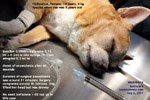 |
|
|
IV drip is advised for long
surgeries. Domitor +
Ketamine IV at the correct
dosage and in healthy dogs
give excellent analgesia
without the need of
isoflurane gas top up. Some
countries may have
difficulties getting
isoflurane vaporisers and
isoflurane and IV
anaesthesia is an
alternative option |
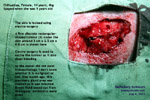 |
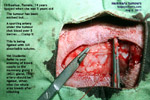 |
  |
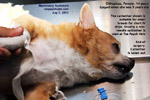 |
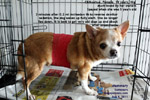 |
 |
|
Drowsy but is awake at the
last stitch |
Antisedan injection wakes
the dog up fast |
Surgery record for knowledge
management |
Although spayed dogs are
said not to get breast tumours, there are a few that will get
breast tumours after spay. There are some reports saying that
female dogs spayed at less than one year of age will have
lower chances of getting breast tumours but I don't find any
scientific research to substantiate this. When was this dog
spayed as I did not think it was done by me.
"When was this dog spayed?" I asked the daughter who has
blossomed into a handsome looking tall lady.
"When I was in JC (junior college)," she put a finger on her
chin to think. "It would be in 1998. She was 5 years old. Now,
she is 14 years old. 8 years sure had breezed by and gone with
the wind. The daughter now becomes the paymaster and the
mother must listen to her. Still both bore the responsibility
of giving the informed consent. The mum wanted me to operate
although Dr Teo would be able to do it. So, that was how I
landed with a surgery on a bright Sunday morning. It was a
happy ending. But the more I do such risky surgeries, the more
the minefields of deaths on the operating table will be
stepped on.
So, I will prefer my younger associate vets to shoulder the
heavy responsibilities of difficult surgeries and high-risk
ones. That is the advantage of team work. There is just no
escaping from the jaws of deaths for high-risk surgeries. It
is a matter of statistics and probability when more of such
cases are done. |
 TOA
PAYOH VETS
TOA
PAYOH VETS TOA
PAYOH VETS
TOA
PAYOH VETS